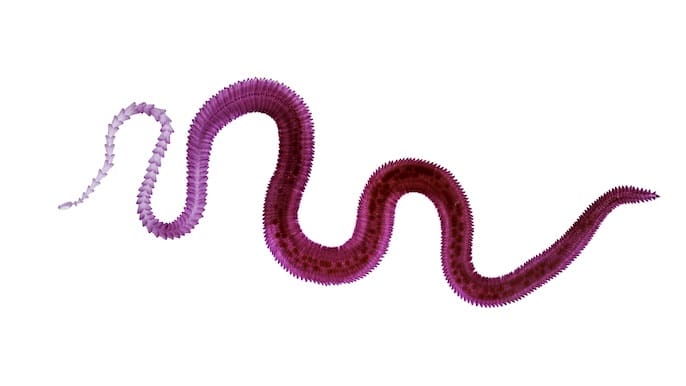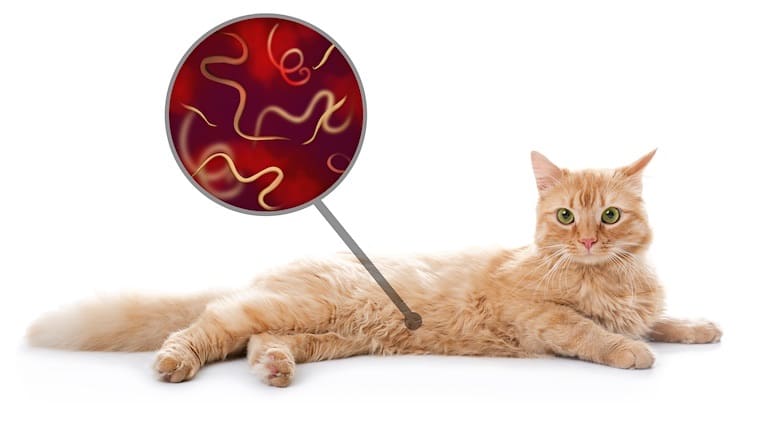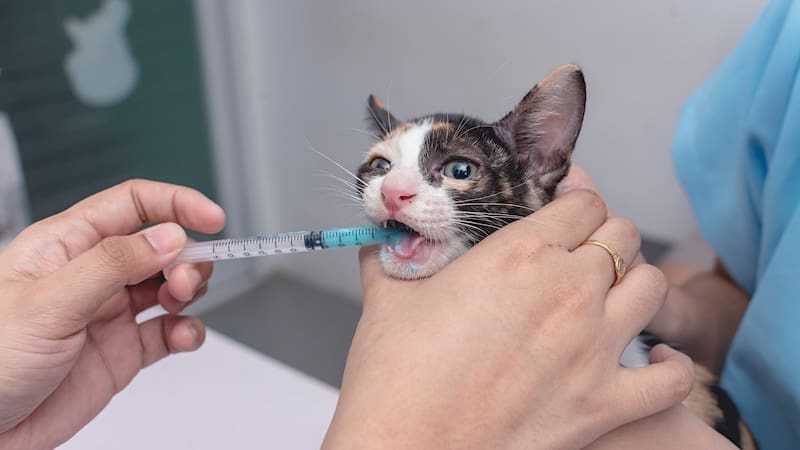Tapeworms can be a serious problem for cats, but should you quarantine your cat if it has tapeworms? Quarantining is one of the most important steps in preventing the spread of these parasites.
Should I quarantine my cat with tapeworms? It makes sense to isolate an infected cat to prevent the spread of eggs and segments around the home. This is particularly important if you have other pets in the house.
Read on for more info as well as finding info on remedies, cleaning approaches and avoidance techniques that can help keep your pet healthy.
What are Tapeworms?
Tapeworms, a form of intestinal parasites, are capable of invading cats, dogs and even people. Tapeworms have flat bodies made up of segments called proglottids which contain eggs.
These worms attach to the walls of the intestine using hooks or suckers and feed on their host’s food. Cats can suffer from weight loss, vomiting, diarrhea and a poor coat if infections are not addressed in time.
What do Tapeworms Look Like?

The good news is that tapeworm segments are usually visible to the naked eye in your cat’s feces or around their anus. They look like small grains of rice or sesame seeds and are often pink, yellow or white in color. However, these segments can break off from the main body of the worm and be scattered throughout your cat’s feces, making them harder to spot.
How Do Cats Get Tapeworms?
Cats typically get a tapeworm infection by ingesting an infected flea during grooming themselves after being outdoors or through eating an infected rodent like a mouse or rat. It is essential to frequently assess for indications of contamination and promptly treat any infestations if your cat has been exposed to these parasites before they become severe.
Although there is always potential risk when dealing with any kind of worm infection, it is unlikely that you will contract tapeworm directly from your cat unless you come into contact with its feces which contains worm segments shed by the parasite.
Therefore, human infection is rare because cats require specific conditions such as an environment where fleas thrive in order for tapeworm eggs to mature into adult worms capable of infecting other hosts.
To maintain your cat’s health, taking the necessary steps to prevent tapeworm infection is essential. Quarantining an infected cat is one of those steps and should be done in order to prevent further spread of infection.
Recap: Tapeworms are an intestinal parasite that can infect cats, dogs, and even humans if contact with infected feces occurs. Cats usually get a tapeworm infection by ingesting fleas or rodents, although it is unlikely for a human to contract the infection directly from their cat as long as they don’t come into contact with its feces containing worm segments.
Should I Quarantine My Cat with Tapeworms?

Cat owners should take the necessary steps when their feline is diagnosed with tapeworm or any other intestinal parasites in order to protect themselves, other pets and their cat. Isolating your feline can help reduce the likelihood of tapeworm eggs and larvae being transmitted around the home, as well as lowering the chances of a second contamination.
How Long Should I Quarantine My Cat For?
The length of time that you should quarantine your cat depends on how severe their tapeworm infection is. For cats with mild tapeworm infections, quarantine may last a few days; for more serious cases, however, up to two weeks or longer of isolation could be necessary. Your veterinarian will be able to provide you with specific advice based on your cat’s individual situation.
During the quarantine, it is vital that other pets are kept away from your unwell cat until they have been completely treated and approved by a vet. You should also thoroughly clean any areas where your cat spends time such as bedding, toys, litter boxes etc., using hot water and detergent before disinfecting them afterwards.
Additionally, it is essential that all members of the household wash their hands after handling or coming into contact with anything related to your infected cat including feces or vomit if present in order to prevent worm re-infection.
Realizing the need for quarantine of an infected cat and its duration is essential to guarantee a secure environment for both you and your pet. With that said, treatment of tapeworms can also help manage the infection; let’s explore what medications are used and how often they should be administered.
Treating Your Cat for Tapeworms

Tapeworms are common intestinal parasites that can infect cats, especially those who are allowed to roam outside. Tapeworms require fleas to complete their life cycle and can be passed from an infected animal or flea to your cat.
Symptoms of tapeworm infection in cats include weight loss, vomiting, diarrhea, scooting on the floor, and visible worm segments in the cat’s feces or around its anus. It is important to treat tapeworm infections as soon as possible to prevent further complications for your cat’s health.
The most common medication used to treat tapeworm infestations in cats is praziquantel (Droncit). This medication works by killing the worms inside your cat’s system without causing any harm or discomfort.
The amount to be given should depend on the seriousness of the infestation, and must always be carried out with veterinary guidance. Generally speaking, one dose of praziquantel every three months is recommended for healthy cats living indoors with no signs of re-infection from pesky parasites like fleas.
If a vet suggests something different than praziquantel for tackling tapeworms in cats, it could be because of multiple worm types or an intense infestation necessitating more intensive therapy compared to just one dose.
In order to guarantee all parasites are eliminated and the chance of re-infection is avoided, further exams may be conducted prior to any deworming medication being given.
Though generally not causing any major repercussions when appropriately treated with drugs like praziquantel, it is possible for cats afflicted by tapeworms to experience slight gastrointestinal distress after taking this dewormer.
This usually resolves itself within 24 hours without requiring medical attention unless symptoms persist beyond this point or become worse over time instead of better. In these cases, it is best to consult with your vet about what other options might exist for managing this bothersome parasite problem effectively without compromising your cat’s wellbeing unnecessarily.
Once the tapeworm infection has been treated with medication, it is essential to thoroughly clean and disinfect your home. For complete decontamination, further details are provided below.
Recap: Tapeworms in felines can be addressed with the drug praziquantel, though more serious instances may necessitate additional testing. Cats who experience gastrointestinal upset after taking this dewormer should consult their veterinarian to discuss alternative options for managing tapeworms without compromising their wellbeing.
Cleaning and Disinfecting Your Home After a Tapeworm Infection in Your Cat
When dealing with tapeworm infection in your cat, the most crucial places to concentrate on for cleaning and disinfection are any surfaces or items that may have been exposed to feces from a contaminated animal.
This includes litter boxes, bedding, toys, food dishes, carpets or rugs where the tapeworm infected cat may have slept or played recently. It is also important to thoroughly vacuum these areas as well as any other areas where fleas might live such as furniture cushions or cracks between floorboards.
Recap: To ensure the prevention of re-infection, it is necessary to thoroughly sanitize any surfaces that may have been exposed to contaminated animal feces. This includes vacuuming carpets or rugs where the cat has slept recently as well as regularly checking up on both your indoor cats’ health and inspecting outdoor areas for signs of infestation – ‘nipping problems in the bud’.
Preventing Future Infestations of Tapeworms in Your Cat
Maintaining your feline’s wellbeing is key to avoiding further tapeworm infestations. To do this, it’s important to understand what steps can be taken to reduce the risk of infection. Vaccines are available that can help protect cats from tapeworms, while natural remedies may also be beneficial.
The first step in preventing future infestations of tapeworms is to ensure your cat is free from fleas and other parasites that could carry the worms into your home.
If you don’t already, seriously consider investing in a quality flea collar such as the Seresto flea and tick cat collar.
Also, if your indoor cat is obsessed with going outside don’t give in to him. A cat allowed to roam free is far more likely to become infested with fleas that pass on the tapeworms.
Regularly vacuum carpets, furniture, bedding, and other areas where pets spend time. Also make sure any outdoor areas are kept free from rodent droppings or other sources of contamination that could contain eggs or larvae from infected animals.
Additionally, keep all food containers tightly sealed so as not to attract pests like mice or rats which may have been exposed to tapeworm eggs or larvae.
Vaccinating cats against tapeworm infections is another way to reduce the risk of a future infestation. There are several vaccines available on the market today that target specific species of tapeworms most commonly found in cats such as Dipylidium caninum (dog flea), Taenia taeniaeformis (cat flea) and Echinococcus multilocularis (fox).
A veterinarian should be consulted for proper administration of the vaccines available in order to ensure their effectiveness against tapeworm species most commonly found in cats, such as Dipylidium caninum (dog flea), Taenia taeniaeformis (cat flea) and Echinococcus multilocularis (fox).
Recap: To protect your cat from contracting worms, check for fleas regularly, keep their environment clean and consider vaccinating them.
FAQ
Is it safe to be around a cat with tapeworms?
Whilst it is unlikely you will get infected by your cat it isn’t impossible.
If you think your cat has tapeworms, you should take them for a veterinary examination immediately. The vet will likely prescribe medication or recommend other treatments to rid the cat of the parasite and reduce any risk of spreading it to other pets or people in contact with the animal.
My cat has worms, how do I clean my house?
It is important to treat your house if your cat has tapeworms. Tapeworms are able to rapidly propagate in the home setting, causing potential health issues for both cats and people.
To prevent the spread of tapeworms it is essential to vacuum and steam clean surfaces, dispose of feces properly, treat other pets in the home with deworming medication prescribed by a vet, and regularly deworm cats living indoors.
Can I still cuddle my cat with worms?
First and foremost, it’s important to understand that tapeworms are not easily transmitted between cats and humans. The most common way for humans to contract the parasite is by accidentally ingesting contaminated feces – which is unlikely to happen during cuddle time.
Additionally, most common intestinal parasites in cats can be easily treated with medication, making them less of a threat than other illnesses.
That being said, it’s still important to take precautions when handling a cat that has parasitic worms.
What to do to your house if your cat has tapeworms?
It is essential to act swiftly if your feline has tapeworms. First, quarantine the cat to prevent the spread of eggs around your home. Next, thoroughly clean the area where your cat spends most of its time and discard any bedding or toys that may have been contaminated with tapeworm eggs.
Next, consult a veterinarian for advice on how to treat the infection and administer any prescribed medication as directed. Finally, ensure proper hygiene practices are followed when handling food bowls and litter boxes in order to prevent re-infection. With diligent care and attention you can help keep your pet healthy while protecting other cats from becoming infected too.
Conclusion
Ultimately, tapeworms pose a risk to cats and their owners alike. If your cat is infected with tapeworms, it’s important to take the necessary steps to treat them as soon as possible. In order to stop the transmission or repetition of contamination, it may be essential to isolate your pet.
With proper treatment and prevention measures, you should be able to keep your cat healthy and free of parasites like tapeworms.
Take proactive steps to protect your garden from neighbourhood cats by installing a cat proof fence or using cat repellent plants. Additionally, seek veterinary advice and follow recommended treatments for any cat with tapeworms in order to keep them healthy and safe indoors.





